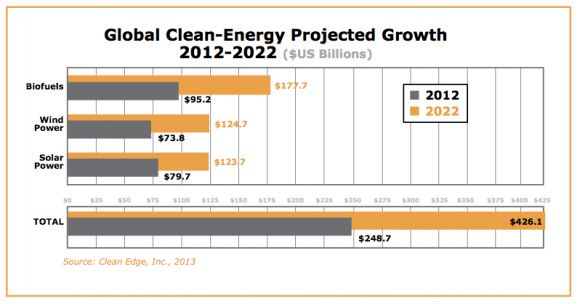Wall Street investors are making big bets on how business will change in a warming world. And no, they're not just looking at the solutions to global warming. As Bloomberg recently pointed out, firms are investing in mining operations where melting ice is exposing new mineral deposits, farming operations in countries where land is constrained, and even "weather derivatives" that provide a hedge against intensifying extreme weather events.
It's easy to be cynical, particularly when global investments in clean energy dipped in 2012.
But the deployment of renewables and efficiency is still on a strong upward trajectory, as the folks at Clean Edge project in their latest report on the state of the industry. Each year, Clean Edge breaks down what's happening in the market and then makes a prediction for the coming decade. The 2013 projections aren't much different than last year's, but they still show nearly a doubling of investment (both public and private) by 2022:

These investment figures give us a rough picture of how much the market will grow. However, it's very difficult to gauge the health of the industry based on these raw numbers.
For example, between 2011 and 2012, the total value of the global solar market dropped by roughly $11 billion. But global solar installations grew during that time period. That's because the falling price of solar technology puts strong downward pressure on manufacturers and allows developers to install more capacity for each dollar invested. Although global investment figures for clean energy dipped last year, it doesn't tell us the full story.
The really interesting portion of the Clean Edge report looks at what trends are driving the coming wave of investment. There are three of particular note: big data, distributed solar financing, and biomimicry.
Indeed, big data is becoming the central piece of our clean energy ecosystem. With companies putting sensors on everything and creating unfathomably large streams of data about how consumers consume, buildings operate, and energy projects deliver energy, visibility has never been better. Investment in the space has surged. The winning companies will be those that understand how to manage that data and make it accessible to the market. Clean Edge believes data management is "one of the hottest things in clean tech this year."
Distributed solar financing has also changed market dynamics in solar. With large Wall Street banks jumping into residential solar services, the U.S. solar market has shifted toward more distribution and slightly away from centralized projects. Solar Mosaic is a company changing the game by bringing crowdfunding to the market by offering small shares of a solar system to individual investors. And Clean Edge points to a potential IRS change to Real Estate Investment Trusts that would allow developers to package solar projects like an investment fund. The research firm believes these developments "could open the floodgates to investment streams that are already starting to flow."
Biomimicry is also an emerging trend. From LED light bulbs to building construction to the design of wind turbine blades, engineers are increasingly looking to nature for cues on how to develop energy technologies. This isn't a new concept by any means, but new advances in materials are making it much easier to implement these designs in the energy space. Clean Edge expects it to be an increasingly important driver in how we think about designing our communities and technologies as it becomes "a notable design philosophy in the realms of clean tech around the world."
Sure, some investment firms may be thinking about how to invest in environmental destruction. But there's still plenty of investment in solutions as well.
